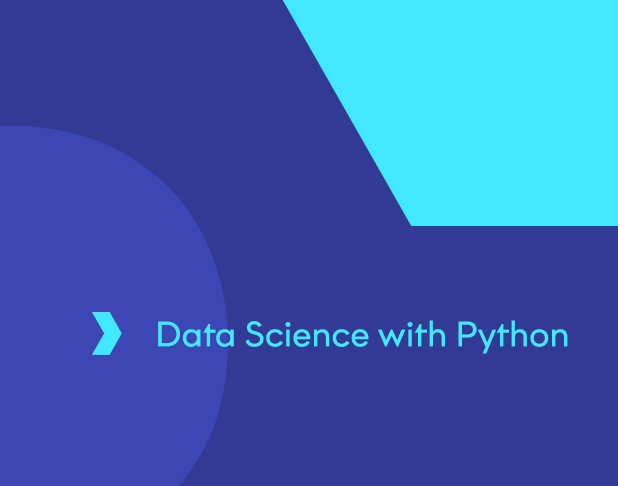Python is a general-purpose programming language that is growing in popularity. Businesses worldwide use Python to harvest insights from data to gain an edge over their competitors. Unlike any other Python course, this one focuses on Python specifically for data science. You’ll learn how to store and manipulate data as well as useful tools to start your own analysis.
Data Science with Python
Select your learning method

Gain an edge in today’s data-driven world on our Data Science with Python course
The Python for Data Science course covers the fundamental concepts of programming with Python and explains data analytics, machine learning, data visualisation, web scraping and natural language processing. You’ll gain a comprehensive understanding of the packages and libraries required to perform data analysis.
By the end of the course, you’ll learn and understand:
- Data science processes, hypothesis building and testing
- Techniques including data wrangling, exploration, and visualisation
- How to install the required Python environment
- Essential concepts of Python programming
- How to perform high-level mathematical computing using NumPy
- How to perform scientific and technical computing using SciPy
- Data analysis execution and manipulation using Pandas
- Supervised and unsupervised learning models
- How to extract useful data from websites using web scrapping
- How you can integrate Python with Hadoop, Spark and MapReduce
What you'll learn
Discover how Python powers data science by mastering data storage, manipulation, and visualisation techniques. Dive into data wrangling with powerful libraries, explore statistical and predictive modelling, and implement machine learning algorithms to tackle real-world challenges with confidence.
Python programming concepts
Mastering Python programming concepts provides numerous benefits. Understanding data types, tuples, lists, and dictionaries allows you to organise and process information efficiently, making it easier to manage complex data. Basic operators enable you to perform calculations and implement logic seamlessly. While functions help you write cleaner, reusable code, saving time and reducing errors. These skills are essential for solving real-world problems and advancing in fields like data science, software development, and automation.
Supervised and unsupervised learning models
Explore Python’s supervised and unsupervised learning models, including linear and logistic regression for predictions and analysis, clustering for grouping data, and dimensionality reduction for simplifying datasets. You’ll also learn about techniques like K-NN and pipeline streamline processes, helping you tackle complex data tasks with ease. These models are key to unlocking insights and driving smarter decisions.
Integrating Python with other tools
Learn how to integrate Python with powerful tools like Hadoop, Spark, and MapReduce to handle big data efficiently. This course shows you how to combine Python’s flexibility with these platforms to process, analyse, and manage massive datasets, making it easier to drive insights and solutions in data-intensive environments.
- Python with Data Science training
- Four real-life industry-based projects
- Interactive learning with Jupyter notebooks labs
Key facts
This is a skills and knowledge-based course with no formal accreditation.
Software professionals, IT professionals or graduates looking to start a career in analytics; analytics professionals interested in working with Python; experienced professionals looking to apply data science in their field.
There are no prerequisites for this data science course and the Python basics course that is included with this programme provides you with additional coding guidance.
There’s no formal exam. To gain your certificate, you must complete the course, at least one project, and score a minimum of 60% in one of the two simulation tests.
There are no optional extras to accompany this course.
There is no pre-course work for this training course.
FAQs
Delivered in partnership with Simplilearn, on this Python Data Science course you’ll develop the skills to analyse and interpret data effectively. Covering Python concepts, data visualisation, and machine learning, it’s perfect for professionals looking to enhance their expertise.
How does the Python programming language help in the field of data science?
Python is a game-changer in data science due to its simplicity, versatility, and vast library ecosystem. It helps you analyse and manipulate data, create visualisations, and build machine learning models with ease. Tools such as Pandas, NumPy, and Matplotlib make complex tasks straightforward, allowing data scientists to focus on uncovering insights and solving real-world problems.
What is Data Science and why is it an attractive career?
Data science helps you turn raw data into meaningful insights using tools including Python, machine learning, and advanced analytics. It’s a highly sought-after field, offering competitive salaries and opportunities across many industries. By solving real-world challenges and making strategic decisions, data scientists play a pivotal role in shaping the future and driving innovation.
How long is the course and is it accredited?
The course is 12 hours long and is a non-accredited skills and knowledge-based course. However, you do receive a certificate once you successfully meet the following criteria; finish the eLearning materials, complete one project out of the two included with the course, and score a minimum of 60% in at least one of the two simulation tests.
Why should I choose this Data Science with Python course?
This Data Science with Python course is perfect for building practical, in-demand skills. It combines Python programming with essential data science techniques like data visualisation, machine learning, and data wrangling. Whether you’re starting out or advancing your career, this course offers hands-on experience and demonstrates your expertise, boosting your employability.

"The ILX customer service team was excellent. They were professional, friendly, and empathetic, guiding me through the registration process and making my experience smooth and hassle-free."

"Great training! Quick and easy communication."
Join the half a million learners developing their skills with our training
A trusted partner to thousands of organisations worldwide
Our passionate team goes above and beyond to support customer needs
Please complete the form to ensure your quote is accurate and we will contact you soon.